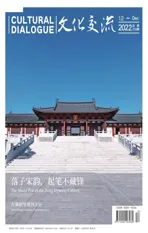在这里,“悦”读宋韵
2023-01-31吴雅兰
文/ 吴雅兰

展厅三展出的唐·韩愈《昌黎先生集》。Collections of Changli’s Works, written by Tang essayist, poet, philosopher and politician Han Yu, are on display.
宋韵文化是具有中国气派和浙江辨识度的重要文化标识。陈寅恪先生曾谓:“华夏民族之文化,历数千载之演进,而造极于赵宋之世。”钱穆先生亦说 :“论中国古今社会之变,最要在宋代。”
宋画因其题材全、技法精,与西方文艺复兴时期的绘画并称为东西两大文明的视觉象征;书法自宋代始重意,确立了全新的美学尺度;宋代版刻与碑刻的繁荣,促进了文化的传播和知识结构的改变。当宋代艺术的这三件瑰宝汇集到一起,流淌千年的宋韵文化瞬间灵动起来。
11月底,由浙江大学艺术与考古博物馆举办的“百代标程—悦读宋韵”专题展集中展示了“中国历代绘画大系”收录的部分宋画调色打样稿和即将出版的《淳化阁帖绍兴国子监本》《浙江图书馆藏淳化阁帖刻石》样稿,宋刻本古籍实物、明清影宋刻本抄本,以及“两宋浙刻丛刊”中已出版的成品和待出版的样张。300多件展品带着观众穿越时光隧道“悦”读宋韵,“悦”读中国优秀传统文化的气象万千。
千年丹青 感受南北宋山水画的异与同
走进展览大厅,映入眼帘的是一块透明的大屏幕,当你用手指轻轻一点,一幅宋画就在指尖慢慢晕染开,山水花鸟亭台楼阁次第铺展在面前,还有那叶扁舟停在无人的渡口……
如果说宋韵文化是一顶宝冠,那么宋画就是宝冠上的明珠。始创于汉唐的各类题材,如山水、花鸟、人物等,宋代皆臻于巅峰,故被称为中国绘画的集大成时代。特别是宋代山水画取得了异常辉煌的成就,“纪念碑”性的宋代山水画是国际学术界公认的人类文化遗产的宝贵财富。
“千年丹青”板块展出了200多幅“中国历代绘画大系”收录的宋画精品出版打样稿,包括李成的《晴峦萧寺图》、范宽的《溪山行旅图》和马远的《踏歌图》等传世“国宝”级宋代山水画珍品。
而如果把北宋和南宋的山水画放在一起,就能明显看出风格的迥异。
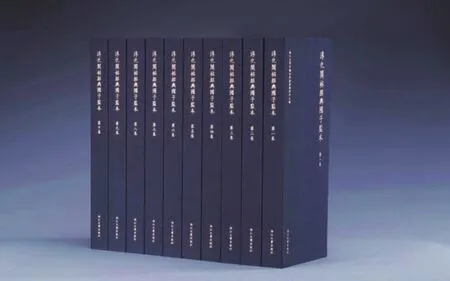
《淳化阁帖绍兴国子监本》。Calligraphic Inscriptions in the Secret Chamber of the Chunhua Period.

展厅现场图。Many pieces of treasure are on display at the exhibition.

两宋浙刻丛刊《唐女郎鱼玄机诗》。Poems of Tang Lady Yu Xuanji, engraved in Zhejiang during the Song dynasty.
“李成的这幅《晴峦萧寺图》就带有明显的北宋‘雄伟山水’的特征。你们看他笔下的山上顶天、下顶地,几乎铺满整个画面。”本次策展的主持者、艺术与考古学院教授缪哲说,北宋画家还非常善于利用前后景来丰富画面的层次,前景的小山小树直接叠加在后景的“主角”之前,用一片缥缈的云雾以示区分,大与小强烈的对比更加凸显了主体山脉的雄伟和永恒,如范宽《溪山行旅图》几乎给人以泰山压顶之感,“而且北宋时期的山水画往往是中轴线构图,画面比较均衡平稳”。
移都杭州后,山水有灵,得益于西湖烟云的浸润,画家致力于捕捉湖山的瞬息之美,从而诞生了南宋的“抒情山水”。比如马远的《踏歌图》,笔法自然灵动,似乎是画家惊鸿一瞥看到的景象,视角更低更近,观众仿佛一抬手就会触碰到画面里的那根枝丫。
除了山水画外,这一板块的花鸟、人物和华藏宝相部分也很有看点。观众在欣赏宋代绘画“诸法皆备”的一流艺术水准之外,更是可以透过这些作品领略两宋时期的世情风物。
宋代绘画对后世影响深远。二战之后,中外学者为“重新发现宋画”做了长期而艰苦的努力,由浙江大学和浙江省文物局共同出版的《宋画全集》正是这一努力的集中体现。此前,《宋画全集》的打样稿已经随着“盛世修典—‘中国历代绘画大系’成果展”在全国多地展出,收获好评如潮。这次宋画精品出版打样稿再次在杭州展出,又得以让观众有机会在半天时间里“阅尽千年”。
刻古传今 细品物质与视觉文化的精雅
这一板块,是可以用放大镜细细探究的。
由隋唐五代传至宋代,版刻扛起了传播知识的大旗。除了官府主持的版刻,民间的刊书业也趋于繁荣,最终形成了以浙江、福建、四川为基地的三大刊书业中心。这一时期的版刻,继承了手抄书的审美,无论是选纸、用墨、板式的设计还是“复制”的工艺都十分考究,堪称艺术品。而物质与视觉文化的精雅,以杭州为中心的“浙刻”可称为其中的翘楚。
展厅最中央的柜子里展出的宋刻本《资治通鉴纲目》五十九卷(存卷四十五)是浙江大学图书馆的镇馆之宝。该藏本由南宋著名藏书家郑寅任吉州(庐陵)知州时捐俸刊刻,主持校刻者为朱熹门生饶谊,是宋版中尤其值得珍视的官刻初印本,也被后人称为庐陵本。
“庐陵本传世稀少,现仅存十五卷。”浙江大学图书馆古籍特藏部程惠新副研究馆员介绍说,此书原为著名实业家和古籍收藏家袁滌庵先生旧藏,1986年,袁氏后人袁绍文、袁绍良等将21种31部296册宋元明清善本捐赠给浙江大学,图书馆专程将其中两种最珍贵的古籍送至上海,请版本目录学家顾廷龙先生鉴定。顾先生在 《袁氏赠书记》中写道:“其中最珍贵者,一为宋刻《资治通鉴纲目》……《纲目》虽属残本,而字大悦目,刻印精良,纸质亦莹洁,实为希世之珍。”
翻开这卷流传近千年的版刻,我们可以看到上面有很多朱笔圈点,还有“朱升之印”“滌庵藏书之印”“康生”“袁绍良印”“袁一诚印”等藏印。如果你用放大镜来看,就会发现墨色非常均匀,既不会漏白,也不会过黑,一切都是恰到好处。
一同亮相的还有浙江大学所藏宋元本古籍,以及浙江古籍出版社出版的“两宋浙刻丛刊” 部分品种和“铁如意馆稿抄本丛刊”所收张宗祥先生部分影宋本样稿。其中,“两宋浙刻丛刊”第一辑原貌仿制的国家图书馆藏《唐女郎鱼玄机诗》,无论文字、刻版,抑或印刷、用纸,堪称宋刻之翘楚,是后世书籍刊刻的标杆。

展厅三内的《东坡诗卷》。Dongpo’s Poetry, on display in exhibition hall 3.
此外,该单元还精选了21件金石拓本,以碑刻、墓志为主,讲述拓本作为一种承载古代文明的独特形式,何以深植于中国人的文化与心灵世界,金石因此成为真正的不朽之物。
翰墨流芳 体味书法艺术的演变与意蕴
说到宋代版刻业,就不得不提中国古代刻帖的冠冕《淳化阁帖》。如果你是书法爱好者,肯定也对这部“法帖之祖”不会陌生—也许你小时候就曾对着它临摹学习。
《淳化阁帖》成书于宋太宗淳化三年(992),是汇编、复制内府所藏的历代法书而成的,共分十卷,卷一为历代帝王书,卷二至四为历代名臣书,卷五为诸家古法帖,卷六至八为王羲之书,卷九至十为王献之书,共收103位书家、420帖墨迹。
《淳化阁帖》代表了我国古代图像机械复制的巅峰。这次展览就展出了浙大出版社正在影印出版的两种《淳化阁帖》。
其中的一种是非常珍贵的南宋初年的“国子监本”。这个版本被珍藏在国内外两个不同的文博机构,虽属同源却难以“相见”。浙江大学“中国历代绘画大系”团队在编纂“大系”的时候,将分藏于上海博物馆与美国弗利尔美术馆的宋拓《淳化阁帖》汇为全帙,使这一沉埋千年的宋韵古刻,得发潜光于盛世。
另外一种是浙江图书馆藏《淳化阁帖》刻石。据专家论证,无论是《淳化阁帖》的“懋勤殿本”还是“潘祖纯本”,都是从同一批原石上拓下来的。而这批石头存世的一部分,就在浙图孤山馆区的碑廊里。在展览中,观众们可以看到这些原石的高清图片。
浙江大学中国古代书画研究中心副主任张钰霖介绍说:“今年刚好是《淳化阁帖》刻成1030周年,我们影印出版两种《阁帖》,既是传承、纪念,也是希望能有更多观众了解书法演变的历史,进一步弘扬中华传统文化。”
细看《淳化阁帖》不同卷册的书法作品,观众们可以明显感受到汉晋书法即兴与自然的风格,而唐代书法讲究的是平衡稳重,带有一点“仪式感”,这种风格一直延续到北宋初期,而后的宋代书法家开始追求个性化的表达,将自己的意趣、心情甚至是一呼一吸都付诸笔端。
这点在该单元后半部分的“尚意书风”展区可以窥见一二。通过北宋四大家苏轼、黄庭坚、米芾、蔡襄,南宋的张即之、陆游、范成大、朱熹,以及宋徽宗、宋高宗的书法墨迹打样稿,观众们可以体味到宋代书法作品笔势、力度和节奏的变化,从细微之处感受千年翰墨的留痕与韵味。
漫步于展厅,观众们也借由这样一次集宋画、书法、宋刻本、宋代碑帖之大成的宋代人文艺术展览,全面品读宋代艺术之风韵、人文气象之意韵、时代精神之气韵。
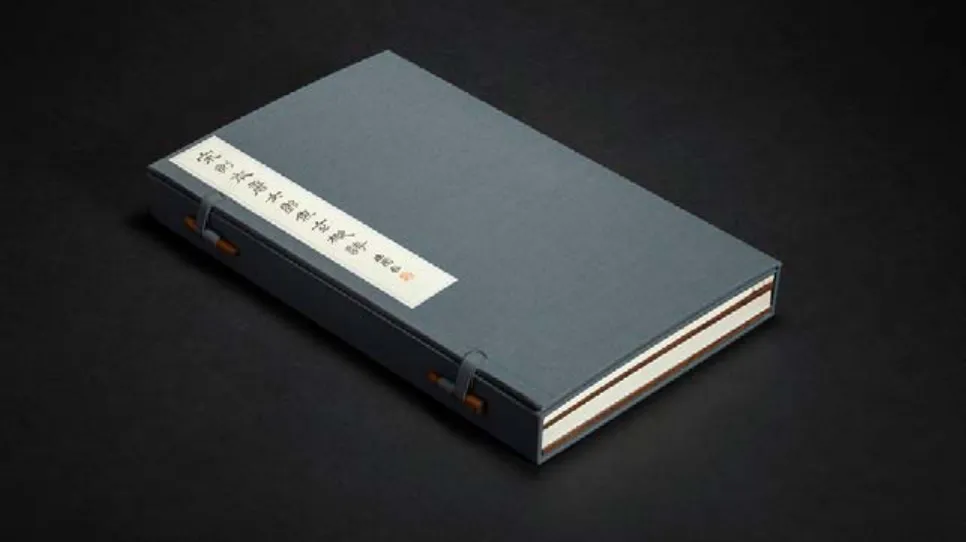
两宋浙刻丛刊《唐女郎鱼玄机诗》。Poems of Tang Lady Yu Xuanji, engraved in Zhejiang during the Song dynasty.
Appreciating the Song Dynasty Culture
By Wu Yalan
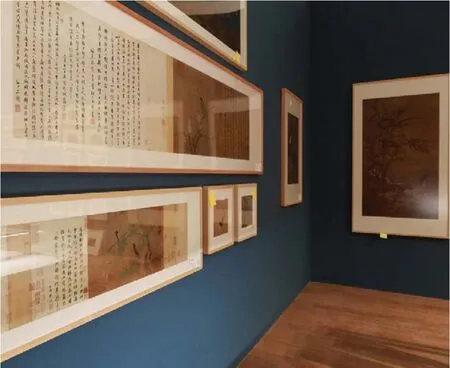
展厅四展出的《竹禽图》。Proofs of Finches and Bamboo, a painting by Emperor Huizong of Song.
The Song dynasty (960-1279) culture is an important cultural symbol of Chinese style typical of Zhejiang. Chen Yinke (1890-1969), a Chinese historian, said, “The culture of the Chinese nation has evolved for thousands of years, culminating in the Song dynasties.” Qian Mu (1895-1990), another historian, also said, “The most important change in China’s ancient and modern society is in the Song.”
Song paintings, with their complete themes and exquisite techniques, are revered as the visual symbols of the major civilizations of the East and the West, just like Renaissance paintings. Calligraphers began to emphasize meaning in the Song dynasty, establishing a new aesthetic standard. The flourishing of book engravings and stele inscriptions in the Song promoted the dissemination of culture and the change of knowledge structure.When these three treasures of the Song come together, the Song culture that has been flowing for a thousand years is instantly alive.
At the exhibitionParagons Through the Ages: Joyful Reading of Song Yun(“Yun” is a Chinese character that means “charm”or “appeal”) held in the Zhejiang University Museum of Art and Archaeology, some of the color proofs of Song paintings included inA Comprehensive Collection of Ancient Chinese Paintingswere displayed, as well as the proofs of Chunhua Chamber Engraved Stones in Zhejiang Library Collection that will be published soon,the original books published in the Song dynasty, and the prints of Song block editions made in the Ming (1368-1644) and Qing(1616-1911) dynasties. More than 300 exhibits take the audience through time, to read the fine traditional Chinese culture.
Walking into the exhibition hall, you will be greeted by a large transparent screen. When you touch it lightly, a Song painting will slowly bloom on your fingertips: landscape, flowers and birds,pavilions and an empty ferry ... If Song culture is a crown, then Song paintings are the pearl on it. All kinds of themes created in the Han (202 BC-220 AD) and Tang (618-907) dynasties, such as landscapes, flowers and birds, figures, etc., reached their peak in the Song. In particular, the landscape paintings of the Song were exceptionally brilliant achievements. The “monument” landscape paintings of the Song are the precious wealth of human cultural heritage recognized by the international academic circles.
The “Millennium Paintings” section displayed more than 200 published proofs of fine Song paintings, including those by Li Cheng (919-967), Fan Kuan (ca. 960-1030), Ma Yuan(1160-1225) and other “National Treasures”. And if you put the landscape paintings of the Northern Song (960-1127) and the Southern Song (1127-1279) dynasties together, you can clearly see the difference in style. The curator of this exhibition Miao Zhe, professor at the School of Art and Archaeology, said that the painters of the Northern Song were good at using the foreground and background to enrich the layers of the picture. “The strong contrast between big and small highlights the majesty and eternity of the main mountain range, like Fan Kuan’s Traveling through Streams and Mountains, which almost gives people the feeling that Mount Tai is overwhelming.”
After the Song capital was moved to Hangzhou, the mountains and rivers had spirits, inspired by the smoke and clouds of the West Lake. The painters were devoted to capturing the fleeting beauty of the lakes and mountains, thus giving birth to the “lyrical landscape”of the Southern Song. For example, Ma Yuan’s pictures had natural and agile brushwork, which seemed to be the scene that the painter saw at a glance. The angle of view was lower and closer, and the audience seems to touch the branch in the picture as soon as they raise their hands. In addition to landscape paintings, the flowers and birds, figures and Buddhist paintings in this section are also interesting. Appreciating the first-class artistic level, the audience can also feel the conditions and customs of the Song.
Paintings in the Song dynasty had a profound influence on later generations. After World War II, Chinese and foreign scholars made long-term and arduous efforts to “rediscover Song paintings”. The A Collection of Song Dynasty Paintings jointly published by Zhejiang University and Zhejiang Provincial Cultural Relics Bureau is a concentrated expression of this effort. Previously,the proofs had been exhibited in many places across China and received rave reviews.
This section can be explored carefully with a magnifying glass.Passed down from the Sui to the Song dynasty, block engraving carried the banner of disseminating knowledge. In addition to the government-sponsored printing, the private publishing industry also prospered, and finally three major publishing centers formed in Zhejiang, Fujian and Sichuan. The engravings of this period inherited the aesthetics of hand-copied books. Whether in selection of paper and ink, block design or “copying” technology,they were all sophisticated and artistic. As for the elegance of material and visual culture, Zhejiang’s blocks centered in Hangzhou are the most outstanding.
The fifty-nine volumes (with forty- five volumes still extant)of the Song engraved edition of Summery of the Comprehensive Mirror for Aid in Government displayed in the cabinet in the center of the exhibition hall are the treasure of Zhejiang University Library. This collection was published by Zheng Yin, a famous bibliophile in the Southern Song dynasty who donated his salary when he was the magistrate of Jizhou (Luling).
“The Luling edition is rare, and there are only fifteen volumes left,” Cheng Huixin, deputy research librarian of the Ancient Books and Special Collections Department of the Zhejiang University Library, said that this book was originally in the old collection of Yuan Di’an, a famous industrialist and ancient book collector. If you look at it with a magnifying glass, you will find that the ink color is uniform, neither white nor too dark, and everything is just right.
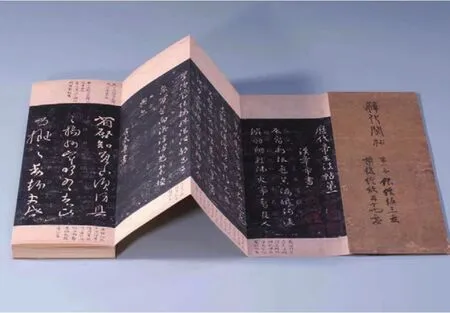
《淳化阁帖绍兴国子监本》。Calligraphic Inscriptions in the Secret Chamber of the Chunhua Period.
In addition, this section also displays 21 rubbings of stone inscriptions, mainly from steles and epitaphs, and tells how rubbings as a unique form of carrying ancient civilization are deeply rooted in the cultural and spiritual world of Chinese people, and thus they become truly immortal.
When it comes to the engraving industry in the Song dynasty,we have to mentionChunhua Chamber Models, the crown of ancient Chinese engraving blocks. If you are a calligraphy lover,you must be familiar with this ancestor in calligraphy — maybe you have copied it when you were a child.
TheChunhua Chamber Modelswere compiled in the year of Chunhua (992), copied from the previous model books collected by the government, with a total of 420 models by 103 calligraphers. This represents the pinnacle of mechanical reproduction of ancient Chinese images. This exhibition includes two kinds of models which are being photocopied and published by Zhejiang University Press. Viewers can see high-resolution pictures of the rough stones conserved in Zhejiang Library, which are the original of the rubbings collected in the forthcoming Models.
The calligraphy in different volumes ofChunhua Chamber Modelsshows the impromptu and natural style of calligraphy in the Han and Jin (266-420) dynasties, while the calligraphy in the Tang dynasty emphasized balance and stability, with a little“ceremonialism”, which lasted until the early Northern Song, and then the calligraphers of the Song began to pursue individualized expression, putting their own interest, mood and even their breath into their brushstrokes. This can be glimpsed in the second half of this section. Through the calligraphy and ink proofs of famous painters and scholars in the Song dynasty, the audience can appreciate the changes in strength and rhythm, feel the traces and charm of millennium calligraphy.
